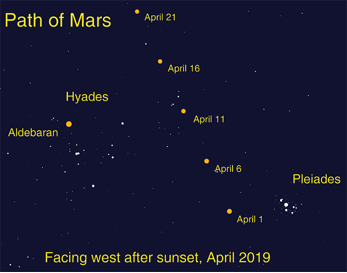April’s skies find Mars traveling between star clusters after sunset, and a great gathering of planets just before sunrise.
Mars shows stargazers exactly what the term “planet” originally meant with its rapid movement across the evening sky this month. The ancient Greeks used the term planete, meaning wanderer, to label the bright star-like objects that travelled between the constellations of the zodiac year after year.
You can watch Mars as it wanders through the sky throughout April, visible in the west for several hours after sunset. Mars travels past two of the most famous star clusters in our night sky: the Pleiades and Hyades. Look for the red planet next to the tiny but bright Pleiades on April 1st. By the second week in April, it has moved eastward in Taurus towards the larger V-shaped Hyades. Red Mars appears to the right of the slightly brighter red-orange star Aldebaran on April 11th. We see only the brightest stars in these clusters with our unaided eyes; how many additional stars can you observe through binoculars?
Open clusters are made up of young stars born from the same “star nursery” of gas and dust. These two open clusters are roughly similar in size. The Pleiades appears much smaller as they are 444 light years away, roughly 3 times the distance of the Hyades, at 151 light years distant. Aldebaran is in the same line of sight as the Hyades, but is actually not a member of the cluster; it actually shines just 65 light years away! By comparison, Mars is practically next door to us, this month just a mere 18 light minutes from Earth – that’s about almost 200 million miles. Think of the difference between how long it takes the light to travel from these bodies: 18 minutes vs. 65 years!
The rest of the bright planets rise before dawn, in a loose lineup starting from just above the eastern horizon to high above the south: Mercury, Venus, Saturn, and Jupiter. Watch this month as the apparent gap widens considerably between the gas giants and terrestrial planets. Mercury hugs the horizon all month, with Venus racing down morning after morning to join its dimmer inner solar system companion right before sunrise. In contrast, the giants Jupiter and Saturn move away from the horizon and rise earlier all month long, with Jupiter rising before midnight by the end of April.
The Lyrids meteor shower peaks on April 22nd, but sadly all but the brightest meteors will be washed out by the light of a bright gibbous Moon.
You can catch up on all of NASA’s current and future missions at nasa.gov
Caption: The path of Mars between the Pleiades and Hyades in April.
Image created with assistance from Stellarium.
This article is distributed by NASA Night Sky Network The Night Sky Network program supports astronomy clubs across the USA dedicated to astronomy outreach. Visit nightsky.jpl.nasa.org to find local clubs, events, and more!


